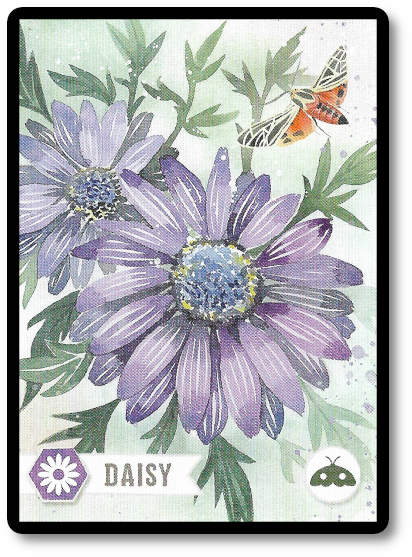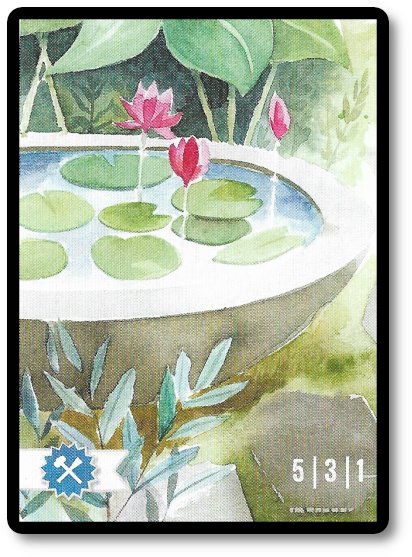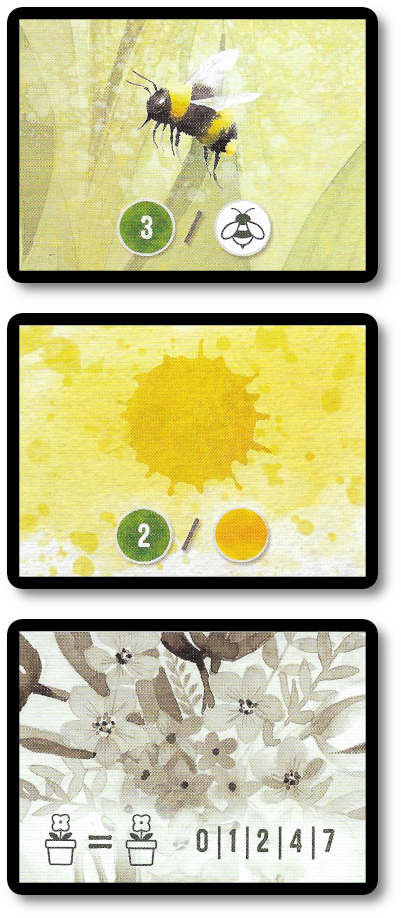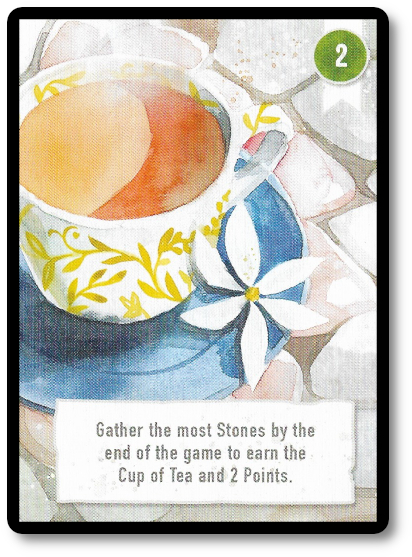
The Basics:
- For ages 10 and up (publisher suggest 14+)
- For 1 to 4 players
- Approximately 20 minutes to complete
Geek Skills:
- Counting & Math
- Logical & Critical Decision Making
- Pattern/Color Matching
- Strategy & Tactics
Learning Curve:
- Child – Easy
- Adult – Easy
Theme & Narrative:
- Take a walk in your lovely garden
Endorsements:
- Gamer Geek approved!
- Parent Geek approved!
- Child Geek mixed!
Overview
Your garden is abundant with color! Insects softly buzz as you walk on the garden path between the rows of bountiful flowers. You pick a Mum or two to make a beautiful arrangement back in your summer cottage, enjoying the peace and tranquility. This game aims to relax and create beauty as you move through a shared garden full of spectacular flowers and lovely statues. Gather the right colors and types of flowers as you traverse your garden to create beautiful arrangements and possibly win the game!
Floriferous, designed by Eduardo Baraf, Steve Finn, Keith Matejka and published by Pencil First Games, is comprised of 60 Garden Cards, nine Bounty cards, 21 Desire cards, four wooden pawns, and a mix of tokens that come in wood and thick cardboard. The cards are as thick and durable as your standard playing card, and the various other game components are just as sturdy. Illustrations by artists Clémentine Campardou and Kim Robinson are bright, beautiful, and perfectly capture the game’s thematic serenity. Not included in the game, but should be used by the players, in a pen or pencil and a pad of paper to record the final scoring.
Planting the Garden
To set up the game for four players, complete the following steps. A summary of solo play is provided in the game variant section of this review. The setup for two and three players is slightly different, but only in the number of cards in play. The rule book does an excellent job describing the differences and provides visual examples.
First, shuffle the Garden cards and Desire cards into two different decks by card type.
Second, deal the four rows of Garden cards in a 5 x 4 grid formation (with the five cards as rows and the four cards as columns). All the Garden cards will be dealt face-up except the second and fourth Garden cards in the topmost row. These are dealt face-down and are meant to be “surprises” for any player who collects them without knowing their value. Thematically speaking, the player is picking these flowers blindly, which works on many levels. Finally, beneath the last row, deal five Desire cards, also face-up. When completed, you will now have a 5×5 grid of cards. This grid is collectively referred to as “the Garden.” Place the remaining Garden and the Desire cards face-down and off to one side at this time.
Third, place a Stone token on the first, third, and fifth Garden cards in the third row, as well as one Stone token on each of the Garden cards in the fourth row. Finally, place all remaining Stone tokens off to one side at this time.
Fourth, shuffle and deal three Bounty cards face-up above the Garden in a row, returning any unused Bounty cards to the game box. Next to the row of Bounty cards, place the “Cup of Tea” card.
Fifth, have each player select the pawn color of their choice and take the matching Flower tokens of the same color. At this time, determine who will be the first player and have each player, in turn, order sequence, place their pawn to the left of the topmost row in the Garden. The first player takes the topmost row, with the next player setting their pawn on the row below that and so on until all the rows have a pawn except the last row that contains the Desire cards.
That completes the game setup. Let’s go walking in the beautiful garden!
Tiptoeing Among the Tulips
Floriferous is played in three “days,” with each day containing five rounds. Players take turns taking action during each of the five rounds. A player’s turn is summarized here.
Turn order is determined by looking at the order of the pawns. The player with the pawn in the topmost row goes first, followed by the second, and so on. As the game progresses, the order in which players will take their turn will change based on which cards they collect.
Action One: Pick from the Garden
The first thing a player does on their turn is to decide which card in the column directly to the right of their pawn (or left during one day in the game) they would like to take, given what cards are available. The card the player picks is taken from the Garden and placed in front of them. If the card selected has a Stone token, these are also collected and placed in front of the player.
The Garden cards come in different varieties. These are flowers, arrangements, and sculptures.
There are five different types of “Flower” Garden cards. Each “Flower” Garden card will display one of five different flowers, one of five different colors, and a possible one of five various bugs. “Flower” Garden cards do not provide points but are necessary to score points. For example, the “Flower” Garden card shown here gives the player one “Daisy,” one purple flower, and a moth.

“Sculpture” Garden cards will give points to the player who collects the most. So, for example, the player with the most would score five points, the next player with the most would score three, and then one point.

“Arrangement” Garden cards are worth points at the end of the game based on all the “Flower” Garden cards the player collects. The requirements for the card are shown at the card’s bottom in the ribbon. For example, the card shown here requires the player to have a “Tulip” of any color, a yellow flower of any type, and any flower of any color with a ladybug. Depending on how many requirements the player can meet, they could score one to five points. It is possible to score all five points using just one card, but certainly no more than three.

The Desire cards, which can also be collected during this action, will award the player points at the end of the game based on what the player collects, with the specific requirements listed on each card. For example, the cards shown here will award the player three points for every card with a bee, two points for every yellow flower, and zero to seven points for the number of similar flowers collected (disregarding color).

If a card has a Stone token, these are placed to one side and will score points for the player for every two they gather at the end of the game and possibly award the player the “Cup of Tea” card.
Note that there are two cards in the Garden that are face-down. These are collected and used just like the cards noted above, with the only difference being that card is “unknown” until the player picks it up during their first action.
Action Two: Move the Pawn
The player’s final action on their turn is to move their pawn and place it in the now-vacant space that once occupied the card the player collected during their first action.
This completes the player’s turn. Then, the next player takes their turn as described above.
Finishing the Day
A “day” is completed when the fifth and final round has been resolved.
All players determine if they completed any of the three Bounty cards found at the top of the Garden. Each Bounty card displays its three requirements that must be met in full. If a player completes all three requirements, they take one of their Flower tokens and place it in one of the three spaces. Each space represents one of the three days, wherein the far left is day one, the middle is day two, and the far right is day three. Players can complete each Bountry card only once, meaning they can only place one of their Flower tokens per Bounty card. If more than one player completes the Bounty card on the same day, they share the space with their Flower tokens.
The Bounty card shown here will give players points if they have any cards that offer the “Daisy,” “Mum,” and “Bee” icons. The number of points scored (five, three, or two) will be determined by which day they meet the Bounty card’s requirements.

When completed, the Garden is cleaned up and reset. Any cards remaining in the Garden are picked up and discarded. A new Garden is then created by dealing the cards in the same manner as when the game was set up. Do not move the pawns at this time. Instead, build the Garden to the left of the pawns for day two and then to the right of the pawns for day three. Movement for days one and three is always to the right, with day two to the left.
The only cards that remain for the duration of the game are the Bounty cards.
Ending the Game
The game comes to an end after the third day. First, determine Bounty card completion and then determine the final score.
The “Cup of Tea” is awarded to the player who has the most Stone tokens. Each player should count their Stone tokens at this time and announce the number collected. If there is a tie, the player with the fewest collected Stone tokens is awarded the “Cup of Tea” card!

Final scoring should be completed using the following steps. Use a piece of paper and a pen or pencil to help record:
- Arrangements: score one, three, or five points for meeting one, two, or three conditions noted on each collected “Arrangement” Garden card. Players can use multiple cards to meet the “Arrangement Garden card’s requirements or just one if they have it.
- Sculptures: score five, three, or one point based on who has the most “Sculpture” Garden cards. The player with the most scores five points, the following highest scores three points, and the player with the following highest scores one point. Players share the same number of points if they tie.
- Desires: score the noted points for each card that meets the “Desire” Garden card’s requirements.
- Stones: score one point for every two Stone tokens collected.
Once each player has their points calculated, add the points from Bountry cards and the “Cup of Tea” card.
The player with the most points wins the game!
Game Variants
Floriferous can be played as a solo garden adventure. The objective is to score as many points as possible and then compare your score against a chart that gives you an idea of how well you did. Of course, the setup is different, and excellent step-by-step details are provided in the rule book. A new deck of cards is introduced that includes a crow that – thematically speaking – is causing a fuss and making it more difficult to relax in your garden. The player goes about scoring as you would normally, but points are taken away by the crow.
While the game is reasonably competitive, players can add an additional level of competition by allowing players to place their Flower tokens during the game the moment the condition on the Bounty is met. Only one Flower token is permitted per space, as well. If another player meets the exact requirements, they place their Flower token on the Bounty but on the next available space. In this way, a Bounty card can become unavailable very early in the game!
If playing with fewer than four players, the Garden is set up using fewer cards. Gameplay is the same, but the lack of abundance represents a smaller garden to enjoy. Fewer choices don’t make for a more complicated game, however.
To learn more about Floriferous, visit the game’s web page.
Final Word
 The Child Geeks enjoyed the game’s colors and components but continued to be tripped up on scoring points until they played several games. According to one Child Geek, “The game is easy to play and fun to walk around your garden. What I didn’t get was how to score points because I didn’t understand what the cards are saying.” It’s not that the icons used are complicated, but they can be confusing for those not familiar with icon use in games. Another Child Geek said, “I liked it! I don’t win, but I like collecting the cards that I think are the prettiest!” This is another reason why the Child Geeks were of a mixed mind when it came to the game. Instinctively, they wanted to collect the prettiest flower cards available to them. This, however, will never bring victory to the player, as Floriferous is a set collecting game, not a flower picking game. Speaking of which, once the last flower was picked, the Child Geeks couldn’t decide if the game was for them or not.
The Child Geeks enjoyed the game’s colors and components but continued to be tripped up on scoring points until they played several games. According to one Child Geek, “The game is easy to play and fun to walk around your garden. What I didn’t get was how to score points because I didn’t understand what the cards are saying.” It’s not that the icons used are complicated, but they can be confusing for those not familiar with icon use in games. Another Child Geek said, “I liked it! I don’t win, but I like collecting the cards that I think are the prettiest!” This is another reason why the Child Geeks were of a mixed mind when it came to the game. Instinctively, they wanted to collect the prettiest flower cards available to them. This, however, will never bring victory to the player, as Floriferous is a set collecting game, not a flower picking game. Speaking of which, once the last flower was picked, the Child Geeks couldn’t decide if the game was for them or not.
 The Parent Geeks had no such doubt, loving the game almost immediately. According to one Parent Geek, “The game is beautiful and casual, relaxing in its execution and engaging in its simplistic gameplay. I very much enjoyed it and would absolutely play it again.” Wow! Very positive! Another Parent Geek reported, “Beautiful colors and theme made for a wonderful game to play with the family. Each turn was meaningful, and I couldn’t help but feel regret as my partner picked flowers that would have been perfect for my flower boot arrangement.” When all the Parent Geeks returned to the garden, they all agreed the Floriferous was a game they very much enjoyed.
The Parent Geeks had no such doubt, loving the game almost immediately. According to one Parent Geek, “The game is beautiful and casual, relaxing in its execution and engaging in its simplistic gameplay. I very much enjoyed it and would absolutely play it again.” Wow! Very positive! Another Parent Geek reported, “Beautiful colors and theme made for a wonderful game to play with the family. Each turn was meaningful, and I couldn’t help but feel regret as my partner picked flowers that would have been perfect for my flower boot arrangement.” When all the Parent Geeks returned to the garden, they all agreed the Floriferous was a game they very much enjoyed.
 The Gamer Geeks, who were not as flowery with their praise as the Parent Geeks, were nonetheless delighted with the game. According to one Gamer Geek, “This is a very light set-collecting game with elements of blocking and a surprising number of times of serious thinking before moving your pawn. I was very pleased with it and would consider the game an excellent filler with gamers.” Another Gamer Geek said, “Excellent casual set-collecting game. It kept me interested, and there is just enough depth to keep each round entertaining. I would recommend this to both my gamer friends and their non-gamer friends, as I don’t have friends who don’t game.” After spending days in their elitist garden, the Gamer Geeks returned home and reported that Floriferous was a winner.
The Gamer Geeks, who were not as flowery with their praise as the Parent Geeks, were nonetheless delighted with the game. According to one Gamer Geek, “This is a very light set-collecting game with elements of blocking and a surprising number of times of serious thinking before moving your pawn. I was very pleased with it and would consider the game an excellent filler with gamers.” Another Gamer Geek said, “Excellent casual set-collecting game. It kept me interested, and there is just enough depth to keep each round entertaining. I would recommend this to both my gamer friends and their non-gamer friends, as I don’t have friends who don’t game.” After spending days in their elitist garden, the Gamer Geeks returned home and reported that Floriferous was a winner.
 Yet another hit from Pencil First Games! I very much enjoy the casual gameplay Floriferous provides while still providing an experience with depth and strategy. The gameplay remains consistently exciting and engaging from the player’s very first step in the garden to the last. As the game progresses, players must consider which cards to collect that give them points that they know of and possible points to be earned by the end of the game. Each step through the garden is a crucial choice, making each opponent’s selection even more interesting to observe.
Yet another hit from Pencil First Games! I very much enjoy the casual gameplay Floriferous provides while still providing an experience with depth and strategy. The gameplay remains consistently exciting and engaging from the player’s very first step in the garden to the last. As the game progresses, players must consider which cards to collect that give them points that they know of and possible points to be earned by the end of the game. Each step through the garden is a crucial choice, making each opponent’s selection even more interesting to observe.
As one of the Child Geeks noted, the icons used in the game can be a bit confusing at first. However, I can report that it only took one game for each player to understand how the cards were scored, with only a few questions during gameplay asking for clarification on what the icons meant. All players must understand how the cards are scored. Make sure you take the time with your friends and family to clarify to avoid upset players at the end of the game. There is nothing worse than ending a game thinking you scored massive points only to find that you scored little to nothing.
Ask me sometime about my epic fail during an intense game of 7 Wonders. I’m still rather upset about it, and that game took place over five years ago.
Do explore this beautiful game and walk its strategic and tactical paths of beauty. I believe you will find it to be a game well worth your time. So take a moment to stop and smell these flowers the very first chance you get!
This game was given to Father Geek as a review copy. Father Geek was not paid, bribed, wined, dined, or threatened in vain hopes of influencing this review. Such is the statuesque and legendary integrity of Father Geek.




I want Floriferous. I just can’t get it anywhere yet. A store having it for “preorder” doesn’t necessarily mean they will have it soon. I guess I can assume by February 2022? Thanks for your review! I already knew I wanted this game, but I still enjoy reading about it while I wait.
It’ll be worth your wait. Thanks for reading the review and leaving a comment!